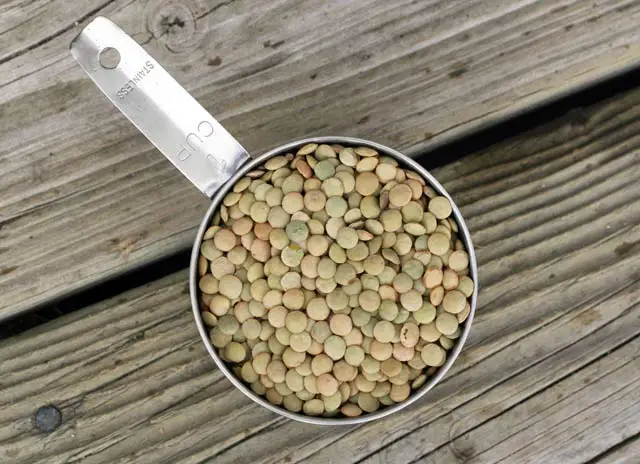Can You Really Add Baking Soda to Lentils?
Lentils are a great source of protein, fiber, and other essential nutrients, which makes them an essential ingredient in any healthy diet. One of the benefits of lentils is that they are easy to prepare. However, some cooks may find it challenging to get the perfect texture or flavor when cooking lentils.
One common practice in preparing lentils is adding baking soda. Baking soda has become a popular ingredient for cooking different dishes, due to its unique properties. In this article, we will explore if you can add baking soda to lentils and whether it’s good for your health.
What is Baking Soda?
Baking soda is alkaline, white, crystalline powder that is commonly used in cooking and cleaning. Its chemical formula is NaHCO3, which means it consists of sodium (Na), hydrogen (H), carbon (C), and oxygen (O). It has a mild alkaline taste and is slightly bitter.
Baking soda has many uses in cooking; it can be used as a leavening agent in baking or as a tenderizer for meat. It also helps neutralize acidic ingredients in recipes by increasing their pH level.
Cooking with Lentils
Lentils are versatile legumes that are packed with flavor and nutrients. When cooked properly, they can be used in various dishes such as soups, stews, and salads. To prepare lentils, you need to rinse them thoroughly with water before soaking them for at least four hours.
Once the soaking time is over, discard the water and use fresh water or broth to cook the lentils. The cooking time will depend on the type of lentil; however, most lentil varieties take about 20-30 minutes to cook.
While lentils are easy to prepare, some mistakes can ruin the dish. For instance, adding salt or acidic ingredients such as vinegar too early in the cooking process can prolong the cooking time and make the lentils tough.
Another issue with lentils is their high content of oligosaccharides, a type of carbohydrate that can cause digestive discomforts like gas bloating and indigestion. However, this can be minimized by properly cooking the lentils and controlling their pH.
Role of pH in Cooking
pH is a measure of acidity or alkalinity in a solution. In cooking, pH plays a vital role in determining the flavor, texture, and appearance of food. A low pH level (acidic) gives food a sour taste while increasing the pH (alkaline) can make it bitter.
The pH level of lentils affects their texture and digestibility. Lentils, like most legumes, have a slightly acidic pH that makes them firm when cooked. However, adding baking soda (an alkaline substance) to lentils increases their pH level, making them softer and more digestible.
The reaction between baking soda and acid produces carbon dioxide gas, which causes leavening. When baking soda is added to lentils while cooking, it reacts with the oligosaccharides and other acidic compounds present in the beans to produce carbon dioxide gas that softens the beans and makes them more palatable.
Uses of Baking Soda
Adding baking soda to lentils has several benefits such as:
- Faster cooking time: The reaction between baking soda and acidic compounds in the beans increases their pH level, which results in softer and faster-cooking beans.
- Better texture: Baking soda breaks down tough fibers present in vegetables such as lentils making them tender and easy to chew.
- Reduced flatulence: Lentils contain oligosaccharides that are not easily digestible, leading to digestive discomforts. The basic pH level of baking soda reduces the levels of oligosaccharides, making them more digestible and reducing the chances of flatulence.
Experimentation on Cooking Lentils with Baking Soda
Cooking lentils with baking soda requires a little experimentation as the amount of baking soda needed may vary depending on the type of lentil, quantity being cooked, or personal preference.
Here’s how to prepare perfect lentils using baking soda:
- Pick your lentils: Select and rinse your preferred type of lentil with water.
- Soak your lentils: Soak your lentils for at least four hours before cooking. This step helps to soften the beans and reduce the cooking time.
- Add baking soda: After soaking, add 1/4 teaspoon of baking soda for every cup of lentils and mix well.
- Cook: Drain and rinse the beans thoroughly and add fresh water or broth according to the cooking instructions. Cook until tender, which usually takes about 20-30 minutes.
Impact on nutrition
Cooking lentils with baking soda reduces the levels of oligosaccharides in lentils, which makes them more digestible, and increases their nutrient absorption.
Lentils are rich in protein, fiber, vitamins, and minerals like folate and iron. When cooked with baking soda, they retain most of their nutrients except for Vitamin C. While heating reduces Vitamin C content in foods, this doesn’t affect other nutrients.
It’s essential to note that adding too much baking soda to cooked lentils can affect their taste and texture. Consuming large amounts of baking soda can also lead to health risks.
Risks and Side Effects
Baking soda is generally safe when consumed in moderate amounts. However, consuming large amounts can lead to various side effects, including:
- Alkalosis: Baking soda is alkaline, and consuming too much of it can raise the pH level in the body, leading to a condition known as alkalosis.
- Electrolyte imbalances: Consuming large amounts of baking soda can interfere with the body’s electrolyte balance leading to muscle weakness, confusion or cramps.
- Digestive issues: While baking soda helps reduce the levels of oligosaccharides in lentils, consuming too much can cause digestive discomfort such as bloating and diarrhea.
FAQs
Here are some frequently asked questions about cooking lentil with baking soda:
Q: How much baking soda should be added to lentils?
A: The amount needed may vary depending on the type of lentil, amount being cooked, or personal preference. As a general rule, add 1/4 teaspoon of baking soda for every cup of lentils.
Q: Can I add baking powder instead of baking soda to lentils?
A: No. Baking powder is a combination of baking soda and acid used for leavening in baked goods. It’s not recommended for cooking lentils.
Q: Is it safe to consume cooked lentils with baking soda?
A: Yes, it’s safe to consume cooked lentils with baking soda in moderation.
Conclusion
Cooking lentils with baking soda can be a great way to enhance their texture and flavor while reducing digestive discomforts. Baking soda has unique properties that help soften and speed up the cooking process of lentils.
However, it’s essential to use baking soda in moderation in cooking as consuming large amounts can lead to health risks. By properly measuring and adding the right amount, you can enjoy delicious and nutritious lentils with minimum digestive issues.
Can adding baking soda to lentils improve their texture?
Yes, adding baking soda to lentils can soften their texture and help them cook faster. However, it can also affect the taste and nutrient content of the lentils if too much is added.
How much baking soda should be added to lentils?
Only a small amount of baking soda is needed when cooking lentils. Generally, one-fourth to one-half teaspoon per cup of dried lentils is enough to soften their texture. It is important not to add too much as it can make the lentils taste bitter.
What are some other benefits of adding baking soda to lentils?
In addition to improving texture and reducing cooking time, adding baking soda to lentils can also reduce their flatulence-inducing effects. This is because it helps break down complex sugars in the lentils that are difficult to digest.
Are there any negative impacts of adding baking soda to lentils?
While adding baking soda can have its benefits, it is important to use it in moderation. Too much baking soda can alter the taste of the lentils and decrease their nutritional value by reducing the amount of vitamins and minerals available for absorption. Additionally, people with heart problems or high blood pressure should avoid using large amounts of baking soda as it can increase sodium levels in the body.





